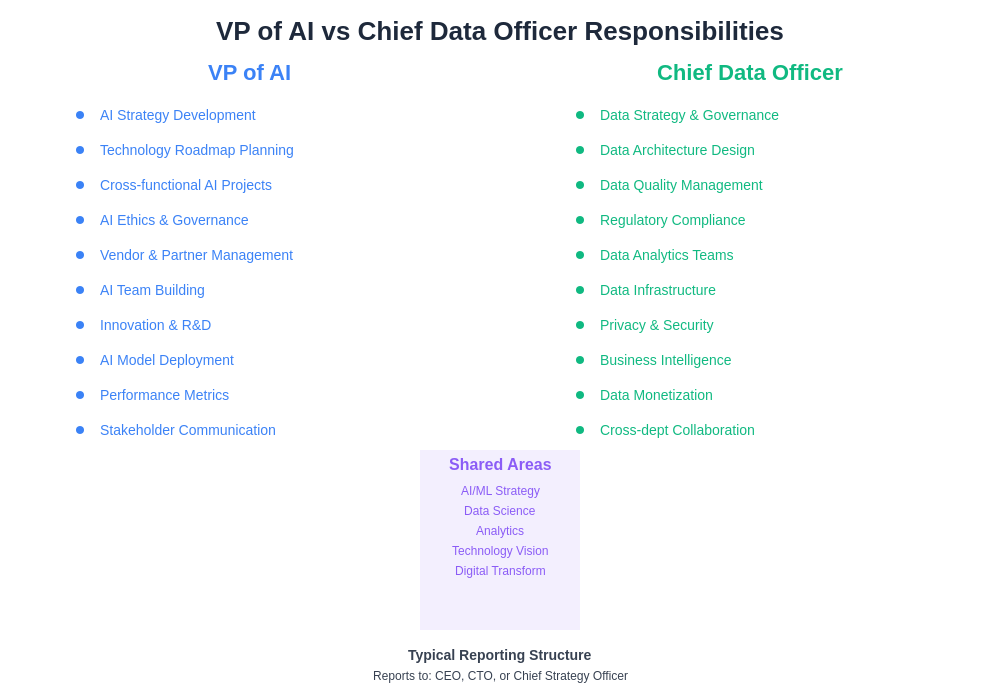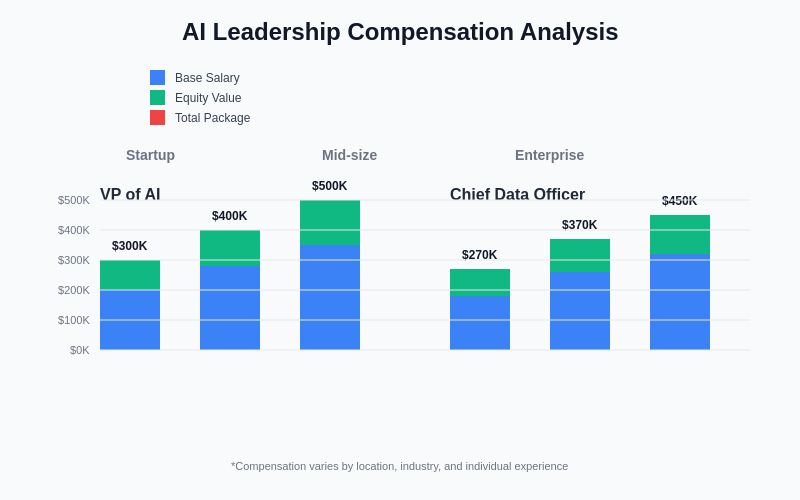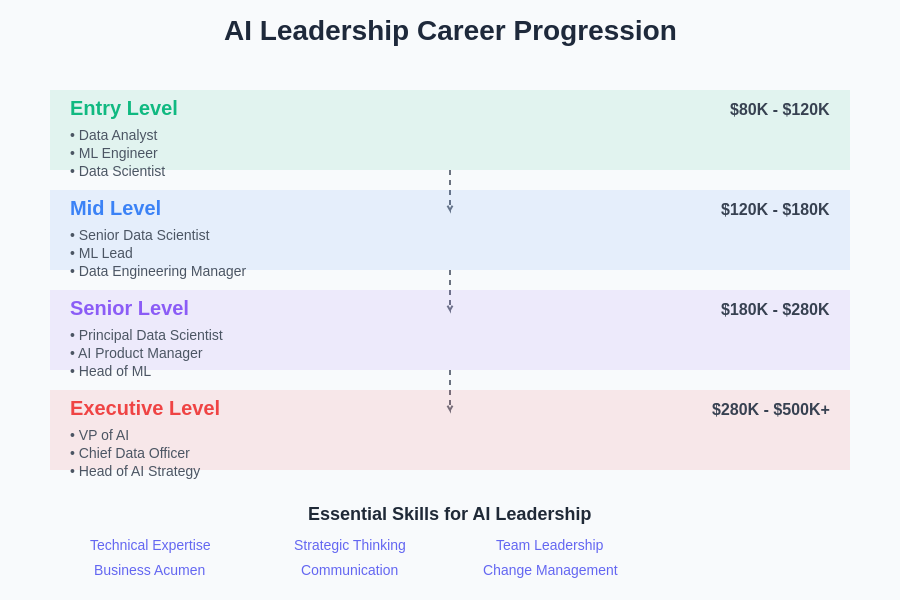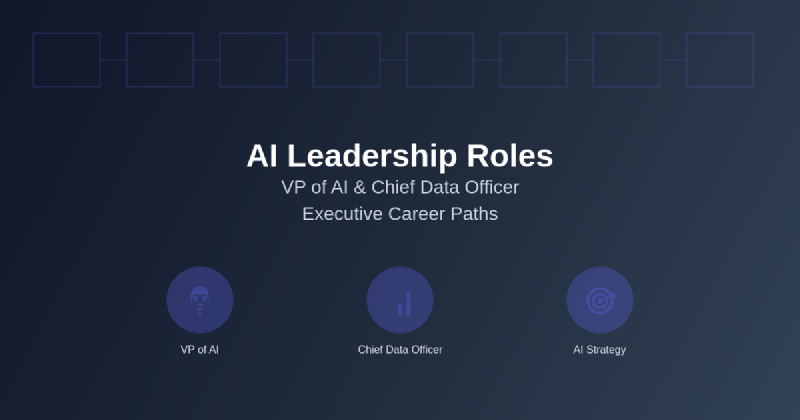The rapid advancement of artificial intelligence across industries has created an unprecedented demand for specialized leadership roles that can navigate the complex intersection of technology, business strategy, and organizational transformation. As companies recognize AI as a fundamental driver of competitive advantage, executive positions such as Vice President of AI and Chief Data Officer have emerged as critical components of modern corporate leadership structures, requiring unique combinations of technical expertise, strategic vision, and transformational leadership capabilities.
Discover the latest trends in AI career opportunities to understand how leadership roles are evolving in response to technological advancement and market demands. The emergence of AI leadership positions represents a fundamental shift in how organizations approach data-driven decision making and technological innovation, creating new pathways for professionals to reach the highest levels of corporate leadership.
The Evolution of AI Executive Roles
The transformation of business operations through artificial intelligence has necessitated the creation of specialized executive positions that can effectively bridge the gap between technical innovation and business strategy. Traditional corporate structures were not designed to accommodate the unique challenges and opportunities presented by AI technologies, leading to the emergence of dedicated leadership roles that focus specifically on artificial intelligence strategy, implementation, and governance.
The Vice President of AI role has evolved from traditional technology leadership positions to encompass strategic planning, cross-functional collaboration, and organizational change management. This position requires leaders who can translate complex technical concepts into business value propositions while maintaining deep understanding of AI capabilities, limitations, and ethical considerations. The role demands exceptional communication skills to interface with board members, investors, and stakeholders who may have limited technical backgrounds but need to understand AI’s impact on business outcomes.
Similarly, the Chief Data Officer position has expanded beyond traditional data management to include AI strategy, machine learning operations, and data-driven innovation initiatives. Modern CDOs must possess comprehensive understanding of data architecture, governance frameworks, and regulatory compliance while simultaneously driving AI adoption and ensuring responsible use of data assets throughout the organization.
Strategic Responsibilities of VP of AI
The Vice President of AI typically serves as the primary architect of an organization’s artificial intelligence strategy, responsible for identifying opportunities where AI can create meaningful business value and competitive advantage. This role requires deep technical knowledge combined with strategic business acumen to evaluate emerging AI technologies, assess their potential impact on existing operations, and develop comprehensive implementation roadmaps that align with broader organizational objectives.
Strategic planning represents a core component of the VP of AI role, encompassing technology assessment, vendor evaluation, partnership development, and resource allocation across multiple AI initiatives. These leaders must maintain awareness of rapidly evolving AI landscape while making informed decisions about which technologies and approaches will deliver the greatest return on investment for their organizations. The position demands exceptional analytical skills to evaluate complex technical solutions and their potential business applications.
Enhance your AI leadership capabilities with advanced tools like Claude to develop comprehensive understanding of AI technologies and their strategic applications across different business contexts. The most successful AI leaders leverage multiple AI platforms and tools to gain diverse perspectives on technological capabilities and limitations.
Cross-functional collaboration represents another critical aspect of the VP of AI role, requiring leaders to work closely with product development, engineering, marketing, sales, and operations teams to identify AI integration opportunities and ensure successful implementation. This collaborative approach necessitates exceptional interpersonal skills and the ability to communicate complex technical concepts to diverse audiences with varying levels of technical expertise.
Risk management and ethical considerations have become increasingly important aspects of AI leadership, requiring VPs of AI to develop comprehensive frameworks for responsible AI development and deployment. These leaders must navigate complex regulatory environments, address bias and fairness concerns, and establish governance structures that ensure AI systems operate transparently and ethically while delivering intended business outcomes.
Chief Data Officer: Beyond Data Management
The modern Chief Data Officer role has evolved significantly beyond traditional data management responsibilities to encompass artificial intelligence strategy, machine learning operations, and data-driven innovation initiatives. Today’s CDOs serve as strategic leaders who leverage data assets to drive business transformation while ensuring compliance with increasingly complex regulatory requirements and privacy standards.
Data strategy development represents a fundamental responsibility of contemporary CDOs, requiring leaders to establish comprehensive frameworks for data collection, processing, storage, and utilization that support both current operational needs and future AI initiatives. This strategic approach demands deep understanding of data architecture, quality management, and governance principles while maintaining focus on business value creation and competitive advantage.
The integration of AI and machine learning capabilities has become a core component of CDO responsibilities, requiring these leaders to develop organizational capabilities for model development, deployment, and monitoring. Modern CDOs must possess sufficient technical knowledge to evaluate AI technologies, assess their potential applications, and establish operational frameworks that support scalable AI implementation across diverse business functions.
Privacy and compliance management have become increasingly complex aspects of the CDO role, particularly as organizations navigate evolving regulatory landscapes such as GDPR, CCPA, and emerging AI-specific regulations. These leaders must establish comprehensive data governance frameworks that ensure compliance while enabling innovative use of data assets for AI and analytics applications.

The distinction between VP of AI and Chief Data Officer responsibilities reflects the specialized nature of each role while highlighting areas of overlap and collaboration. Understanding these role definitions helps organizations structure their leadership teams effectively and ensures clear accountability for different aspects of AI and data strategy implementation.
Career Pathways and Professional Development
The journey to AI leadership roles typically involves diverse professional experiences that combine technical expertise with business acumen and leadership capabilities. Most successful AI executives have backgrounds that span multiple disciplines, including computer science, data science, business strategy, and organizational leadership, creating unique skill sets that enable them to navigate complex technological and business challenges.
Technical foundation building represents a critical early career focus for aspiring AI leaders, typically involving hands-on experience with machine learning, data analytics, software development, and system architecture. Many successful AI executives begin their careers as data scientists, machine learning engineers, or software developers, gaining deep understanding of AI technologies and their practical applications before transitioning to leadership roles.
Business acumen development often occurs through exposure to strategic planning, product management, consulting, or business development roles that provide insight into market dynamics, customer needs, and competitive positioning. This business perspective is essential for AI leaders who must translate technical capabilities into market opportunities and business value propositions.
Explore comprehensive AI research capabilities with Perplexity to stay informed about industry trends, emerging technologies, and best practices that inform strategic decision-making in AI leadership roles. Continuous learning and market awareness are essential for maintaining effectiveness in rapidly evolving AI landscape.
Leadership experience typically develops through progressive management responsibilities, including team leadership, project management, and cross-functional collaboration. Many AI executives gain valuable experience leading technical teams, managing complex projects, and interfacing with senior leadership before assuming executive roles that require broader organizational influence and strategic responsibility.
Essential Skills and Competencies
Successful AI leadership requires a unique combination of technical knowledge, business strategy expertise, and transformational leadership capabilities that enable executives to drive organizational change while maintaining focus on business outcomes and competitive advantage. The most effective AI leaders possess deep understanding of artificial intelligence technologies combined with exceptional communication skills and strategic thinking abilities.
Technical competency in AI and machine learning represents a foundational requirement for these leadership roles, though the depth of technical knowledge may vary depending on organizational needs and industry context. AI executives must understand machine learning algorithms, data architecture principles, model development processes, and deployment considerations sufficiently to make informed strategic decisions and communicate effectively with technical teams.
Strategic thinking and business acumen are equally important competencies that enable AI leaders to identify market opportunities, assess competitive dynamics, and develop comprehensive strategies that leverage AI technologies for business advantage. These skills include market analysis, financial modeling, risk assessment, and strategic planning capabilities that inform decision-making about AI investments and initiatives.
Communication and stakeholder management skills are critical for AI leaders who must interface with diverse audiences, including board members, investors, customers, and technical teams. The ability to translate complex technical concepts into business language while maintaining accuracy and credibility is essential for securing support for AI initiatives and driving organizational adoption of new technologies.
Change management and organizational development capabilities have become increasingly important as AI implementation often requires significant changes to business processes, organizational structures, and cultural norms. Successful AI leaders must be able to guide organizations through complex transformations while maintaining employee engagement and operational effectiveness.
Organizational Impact and Value Creation
AI leadership roles are uniquely positioned to drive significant organizational value through strategic technology adoption, operational optimization, and innovation acceleration. These positions create measurable impact across multiple business dimensions, including revenue growth, cost reduction, operational efficiency, and competitive positioning that directly contribute to organizational success and market leadership.
Revenue generation through AI initiatives represents a primary value creation opportunity for AI leaders, encompassing new product development, market expansion, customer acquisition, and pricing optimization. Successful AI executives identify and capture opportunities to monetize AI capabilities through enhanced products, services, and business models that create sustainable competitive advantages.
Operational efficiency improvements often result from AI-driven automation, process optimization, and decision support systems that reduce costs while improving quality and speed of business operations. AI leaders must identify high-impact automation opportunities and successfully implement solutions that deliver measurable productivity gains and cost savings.
Risk mitigation and compliance management represent increasingly important aspects of AI leadership value creation, particularly as organizations face growing regulatory scrutiny and stakeholder expectations regarding responsible AI use. Effective AI leaders establish governance frameworks that protect organizations from regulatory, reputational, and operational risks while enabling innovation and growth.
Innovation acceleration through AI adoption can create significant competitive advantages by enabling organizations to develop new capabilities, enter new markets, and respond more quickly to changing customer needs. AI leaders play critical roles in fostering innovation cultures that leverage artificial intelligence for continuous improvement and strategic differentiation.
Compensation and Career Prospects
The compensation landscape for AI leadership roles reflects the strategic importance of these positions and the scarcity of qualified candidates with appropriate combinations of technical expertise and business leadership experience. Salary ranges for VP of AI and Chief Data Officer positions vary significantly based on organization size, industry sector, geographic location, and individual experience levels, but generally represent premium compensation packages that reflect the specialized nature of these roles.
Base salary ranges for VP of AI positions typically fall between $250,000 and $500,000 annually, with additional equity compensation that can significantly increase total compensation packages. Chief Data Officer positions often command similar base salary ranges, with total compensation frequently exceeding $600,000 annually when including equity, bonuses, and other incentive structures.
Geographic location significantly influences compensation levels, with major technology hubs such as Silicon Valley, New York, Seattle, and Boston typically offering premium compensation packages compared to other markets. However, the increasing acceptance of remote work has begun to normalize compensation differences across geographic regions, particularly for senior leadership roles.
Industry sector also plays a significant role in determining compensation levels, with technology companies, financial services, healthcare, and consulting firms typically offering the highest compensation packages for AI leadership roles. These industries often compete aggressively for top AI talent and are willing to pay premium compensation to secure leaders who can drive strategic AI initiatives.

The compensation structure for AI leadership roles reflects both the strategic importance of these positions and the competitive market dynamics for executive-level AI talent. Understanding these compensation patterns helps both professionals and organizations establish appropriate expectations for AI leadership recruitment and retention strategies.
Career progression prospects for AI leaders remain exceptionally strong as organizations continue to recognize the strategic importance of artificial intelligence and data-driven decision making. Many AI executives advance to broader C-suite roles, including Chief Technology Officer, Chief Innovation Officer, or even Chief Executive Officer positions, leveraging their unique combination of technical expertise and business leadership experience.
Industry-Specific Considerations
The application of AI leadership varies significantly across different industry sectors, each presenting unique challenges, opportunities, and regulatory considerations that influence the specific requirements and responsibilities of VP of AI and Chief Data Officer roles. Understanding these industry-specific dynamics is crucial for professionals seeking to maximize their effectiveness and career advancement in AI leadership positions.
Financial services represents one of the most mature sectors for AI adoption, with applications spanning fraud detection, algorithmic trading, risk management, customer service, and regulatory compliance. AI leaders in financial services must navigate complex regulatory environments while implementing solutions that enhance operational efficiency and customer experience. The sector’s emphasis on risk management and regulatory compliance creates additional responsibilities for AI executives who must ensure all AI initiatives meet stringent oversight requirements.
Healthcare and life sciences present unique opportunities and challenges for AI leadership, with applications including diagnostic imaging, drug discovery, personalized medicine, and clinical decision support. AI leaders in healthcare must address complex ethical considerations, patient privacy requirements, and regulatory approval processes while developing solutions that improve patient outcomes and reduce healthcare costs.
Retail and e-commerce sectors have embraced AI for applications such as recommendation systems, inventory optimization, dynamic pricing, and customer analytics. AI leaders in retail must focus on customer experience enhancement and operational efficiency while managing complex supply chain considerations and competitive dynamics that require rapid innovation and deployment capabilities.
Manufacturing industries increasingly leverage AI for predictive maintenance, quality control, supply chain optimization, and automated production processes. AI leaders in manufacturing must understand operational technology integration, safety requirements, and industrial automation standards while developing solutions that improve productivity and reduce operational costs.
Building Effective AI Organizations
The success of AI leadership roles depends significantly on the ability to build and manage effective organizational structures that support AI development, deployment, and scaling across enterprise operations. This organizational development requires careful attention to team composition, skill development, cultural transformation, and operational processes that enable sustainable AI adoption and continuous innovation.
Team building and talent acquisition represent critical responsibilities for AI leaders who must assemble diverse teams with complementary skills in machine learning, data engineering, software development, and business analysis. The challenge of attracting and retaining top AI talent requires competitive compensation packages, compelling career development opportunities, and engaging project assignments that enable professional growth and technical advancement.

The career progression pathway to AI leadership positions typically spans multiple experience levels, each requiring specific skill development and increasingly sophisticated responsibilities. Understanding these progression stages helps professionals plan their career development and organizations structure appropriate advancement opportunities for emerging AI talent.
Organizational culture development is essential for successful AI implementation, requiring leaders to foster environments that encourage experimentation, learning from failure, and continuous improvement. AI leaders must champion cultural changes that support data-driven decision making, cross-functional collaboration, and innovative problem-solving approaches that leverage artificial intelligence capabilities.
Process development and standardization enable organizations to scale AI initiatives effectively while maintaining quality, consistency, and compliance with organizational policies and regulatory requirements. AI leaders must establish comprehensive frameworks for model development, testing, deployment, and monitoring that ensure reliable operation and continuous improvement of AI systems.
Future Outlook and Emerging Opportunities
The future landscape for AI leadership roles continues to evolve as artificial intelligence technologies advance and organizations develop more sophisticated approaches to AI adoption and integration. Emerging trends such as generative AI, edge computing, quantum machine learning, and autonomous systems create new opportunities and challenges that will shape the responsibilities and requirements of future AI leaders.
Generative artificial intelligence represents a particularly significant development that is transforming how organizations approach content creation, software development, customer service, and creative processes. AI leaders must develop strategies for incorporating generative AI capabilities while addressing concerns about intellectual property, quality control, and ethical use of AI-generated content.
Edge computing and distributed AI deployment create new technical and strategic considerations for AI leaders who must develop capabilities for deploying and managing AI systems across diverse computing environments. This trend requires understanding of hardware optimization, network latency considerations, and security implications of distributed AI deployment.
The integration of AI with emerging technologies such as Internet of Things, blockchain, and augmented reality creates additional opportunities for innovative applications and business model development. AI leaders must stay informed about these technological convergences and their potential applications across different industry sectors and use cases.
Regulatory development and AI governance frameworks continue to evolve, creating new compliance requirements and oversight responsibilities for AI leaders. The most successful executives will be those who can navigate these regulatory landscapes while maintaining focus on innovation and business value creation through responsible AI development and deployment.
The continued advancement of AI technologies and their integration into business operations ensures that demand for experienced AI leadership will continue to grow across industries and organization sizes. Professionals who develop comprehensive understanding of AI technologies, business strategy, and organizational leadership will be well-positioned to capitalize on these expanding opportunities and drive meaningful impact through artificial intelligence adoption and innovation.
Disclaimer
This article is for informational purposes only and does not constitute career or professional advice. The information presented reflects current market conditions and industry trends that may change over time. Compensation figures are approximate and may vary significantly based on individual circumstances, geographic location, and specific organizational requirements. Readers should conduct their own research and consult with career professionals when making decisions about career transitions or leadership role pursuits.
